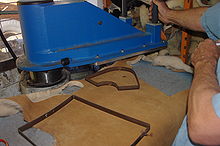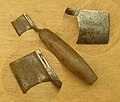287:
275:
263:
176:
33:
286:
213:
167:
It is a skilled trade because it is the clicker's responsibility to maximise the number of uppers which can be cut from skins of leather, avoiding any thin and damaged areas, and incorporating the (unseen) 'lines' of stretch and resistance which naturally occur in leather according to the style and
224:. To use a rap stick, a right-handed operator would hold it in the left hand, resting the stick on the workbench for support, stroking the blade rapidly but gently back and forth on the abrasive surface to maintain a sharp edge whilst hand-cutting, in a similar fashion to a butcher's knife and
208:
Hand-clicking skills are still needed in low-volume production of bespoke, hand-made shoes or as sales-samples for factory production, although these would not warrant the expense of brass-binding used to protect the edges of the pattern from being pared away.
152:
The job was historically named prior to mechanisation, due to the sound of the operator's hand-knife blade rattling against the brass edge-binding (including the joints in the binding) used to protect the board patterns which were overlaid on to the skin.
179:
Placing sharpened-edge steel patterns on to sheepskin, the hydraulic machine has a swivelling cutting head with two vertical handles, each having an embedded button for thumb operation, a safety device to prevent accidental actuation of the vertical
256:, although the materials, whether natural leathers, rubbers or synthetics, are heavier for durability. The clicker would also cut these materials in a small manufacturing facility, whereas larger-scale production would have dedicated operators.
205:, the sounds changed entirely to a heavy thump and/or crack, with the board pattern with hand-knife being replaced by a 'knife' similar to a pastry cutter, although the operator still needed to learn hand-clicking as part of the training.
296:
by manufacturer showing direction where shoe insole patterns should be placed. The board is formulated to have different properties along its length compared to across, to allow for shoe-flex and manufacturing
274:
228:. The knife blade shown is a lighter medical item but approximates the shape of a clicker's knife blade, fitting into a comfortable wooden handle with screw-activated jaws. The main surface is
149:
or piece of man-made material (usually from a bulk roll). This includes all components of the upper, including linings, facings, stiffeners, reinforcements for eyelets and zip-protectors.
156:
In larger factories there would be many hand-clickers in close proximity to one another, hence there would be many clicks per second, so the informal description became known as
232:
wrapped over the edge to form a round section where the curved blade can nestle and be sharpened; the top edge is sharper and square in cross-section, with a fine-grain
366:
Positioning the press-knife/pattern on leather placed on the nylon cutting-board of an hydraulic press prior to swivelling the press-head and cutting via a downstroke
172:
the respective parts of the shoe uppers which are cut as a pair, not only matching the colour variations but also considering the surface finish and grain texture.
190:
were first introduced, and together with fabrics these also had lines of stretch and tension, being based on a traditional woven base having threads of
314:
262:
97:
69:
50:
76:
83:
116:
17:
65:
280:
Vintage Texon 480 insole board offcut showing direction of cut-outs where shoe insole patterns have been placed
54:
338:
185:
354:
The late Baden Wilson demonstrating hand-clicking, using a hand-knife around a board 3/4 vamp pattern
326:
365:
359:
353:
90:
43:
252:
Similar processes are used in preparing materials for the sole and heel of shoes, known as
220:
The clicker's knife regularly needed sharpening, which was done with an implement called a
8:
386:
371:
233:
191:
380:
360:
Hand-forming a press-knife, using pre-sharpened strip steel from a bulk coil
168:
construction of the particular shoe. Another major criterion is the need to
225:
241:
237:
229:
202:
175:
134:
236:
used for tip-sharpening. On the reverse side is a heavy-leather smooth
216:
A vintage Rap Stick from 1940s used for sharpening a clicker's knife
32:
292:
Close-up of Texon 480 insole board with direction of cut marked as
146:
212:
195:
142:
138:
201:
Following the introduction of electrical/mechanised
57:. Unsourced material may be challenged and removed.
378:
184:During the late 1960s synthetic leathers called
268:Leather cutter's drag knife, for heavy leathers
341:Rushden Research Group. Retrieved 2014-09-24
329:Rushden Research Group Retrieved 2014-09-24
247:
117:Learn how and when to remove this message
211:
174:
14:
379:
55:adding citations to reliable sources
26:
24:
25:
398:
347:
372:Clicking knife handle and blades
285:
273:
261:
31:
42:needs additional citations for
332:
320:
308:
244:left by the abrasive process.
234:aluminium oxide abrasive strip
13:
1:
302:
7:
133:is the person who cuts the
10:
403:
339:Overview of Bottom Stock
240:, to address any metal
66:"Boot and shoe clicker"
248:Bottom stock materials
217:
181:
215:
178:
131:boot and shoe clicker
368:Retrieved 2014-05-05
362:Retrieved 2014-05-05
356:Retrieved 2014-05-05
327:Overview of clicking
317:Retrieved 2014-09-24
51:improve this article
218:
182:
127:
126:
119:
101:
18:Bootmaker clicker
16:(Redirected from
394:
342:
336:
330:
324:
318:
312:
289:
277:
265:
226:sharpening steel
122:
115:
111:
108:
102:
100:
59:
35:
27:
21:
402:
401:
397:
396:
395:
393:
392:
391:
377:
376:
350:
345:
337:
333:
325:
321:
315:Clicking knives
313:
309:
305:
298:
290:
281:
278:
269:
266:
250:
145:from a skin of
123:
112:
106:
103:
60:
58:
48:
36:
23:
22:
15:
12:
11:
5:
400:
390:
389:
375:
374:
369:
363:
357:
349:
348:External links
346:
344:
343:
331:
319:
306:
304:
301:
300:
299:
291:
284:
282:
279:
272:
270:
267:
260:
249:
246:
180:cutting-stroke
125:
124:
107:September 2014
39:
37:
30:
9:
6:
4:
3:
2:
399:
388:
385:
384:
382:
373:
370:
367:
364:
361:
358:
355:
352:
351:
340:
335:
328:
323:
316:
311:
307:
295:
288:
283:
276:
271:
264:
259:
258:
257:
255:
245:
243:
239:
235:
231:
227:
223:
214:
210:
206:
204:
199:
197:
193:
189:
188:
177:
173:
171:
165:
163:
159:
154:
150:
148:
144:
140:
136:
132:
121:
118:
110:
99:
96:
92:
89:
85:
82:
78:
75:
71:
68: –
67:
63:
62:Find sources:
56:
52:
46:
45:
40:This article
38:
34:
29:
28:
19:
334:
322:
310:
293:
254:bottom stock
253:
251:
221:
219:
207:
200:
186:
183:
170:colour-shade
169:
166:
161:
157:
155:
151:
130:
128:
113:
104:
94:
87:
80:
73:
61:
49:Please help
44:verification
41:
230:emery cloth
387:Shoemaking
303:References
77:newspapers
297:processes
222:rap stick
187:pormerics
381:Category
294:Cut Thus
162:clickers
158:clicking
203:presses
147:leather
91:scholar
135:uppers
93:
86:
79:
72:
64:
242:burrs
238:strop
143:shoes
139:boots
137:for
98:JSTOR
84:books
196:weft
194:and
192:warp
70:news
160:by
141:or
53:by
383::
198:.
164:.
129:A
120:)
114:(
109:)
105:(
95:·
88:·
81:·
74:·
47:.
20:)
Text is available under the Creative Commons Attribution-ShareAlike License. Additional terms may apply.




